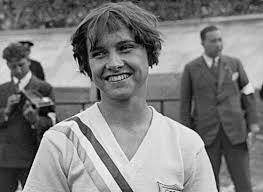In the roaring 1920s, when women were still fighting for basic rights and respect in sports, a teenage girl from Illinois changed history forever. Her name was Betty Robinson, and in a single summer, she went from running her first competitive race to becoming the first woman to win Olympic gold in track and field. But her story didn’t stop there in fact, it barely began.
A Star is Born — Almost by Accident
Betty Robinson wasn’t training to be an Olympic athlete. In fact, she was discovered by her high school science teacher, who also happened to be a track coach, after he noticed her sprinting to catch a train. Realizing her natural speed, he entered her into a local meet and she won. Then, with just a few months of training, she qualified for the 1928 Amsterdam Olympics, the first Games to include women’s track and field.
At just 16 years old, Robinson stunned the world by winning the 100-meter dash, making her the first woman in history to claim Olympic gold in a sprinting event. She had never even raced the 100 meters before arriving in Amsterdam.
A Tragedy That Nearly Ended Everything
Just three years after her Olympic triumph, in 1931, Robinson was involved in a near-fatal plane crash. She was thrown from the wreckage and found unconscious so badly injured, in fact, that rescuers initially believed she was dead. She suffered a broken leg, fractured pelvis, and severe head injuries. Doctors told her she might never walk again, let alone run.
Most athletes’ stories would end there. But Betty Robinson’s didn’t.
The Greatest Comeback in Sports History
After two years of recovery, Robinson was able to walk again but she couldn’t crouch into a sprinter’s starting position due to the lasting effects of her injuries. That meant she couldn’t run individual sprints competitively. But Robinson wasn’t ready to quit.
Instead, she trained for the 4×100-meter relay, where starting blocks weren’t required for all runners. Against the odds, she made the 1936 U.S. Olympic team and traveled to Berlin, where she ran the third leg of the relay. The Americans won gold, and Betty Robinson became a two-time Olympic champion, eight years apart with a plane crash and an almost total physical recovery in between.
More Than a Medalist — A Trailblazer
Robinson’s career helped prove that women not only belonged in track and field, but could command the world’s attention with their strength, skill, and courage. She competed at a time when female athletes were often dismissed or even mocked. Her victories helped legitimize women’s sports in the eyes of the public and inspired a generation of girls to dream bigger.
Yet, Robinson never sought the spotlight. She quietly returned to life in Illinois, working as a school secretary and participating in the Olympic movement as a volunteer and speaker. Her humility made her legacy even more powerful.
A Legacy of Quiet Power
Betty Robinson may not be a household name today, but her influence on sports especially women’s athletics is undeniable. She shattered stereotypes, survived a literal crash landing, and returned to the very top of her sport. Few athletes in any discipline have demonstrated that kind of perseverance.
In a century filled with flashy victories and high-profile comebacks, Betty Robinson’s story stands apart: not because it was loud, but because it was deeply human. She didn’t just change women’s track and field she redefined what an athlete could endure, overcome, and achieve.
From a train platform in Illinois to Olympic gold twice Betty Robinson didn’t just run races. She ran into history.

